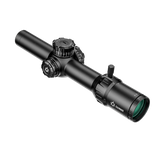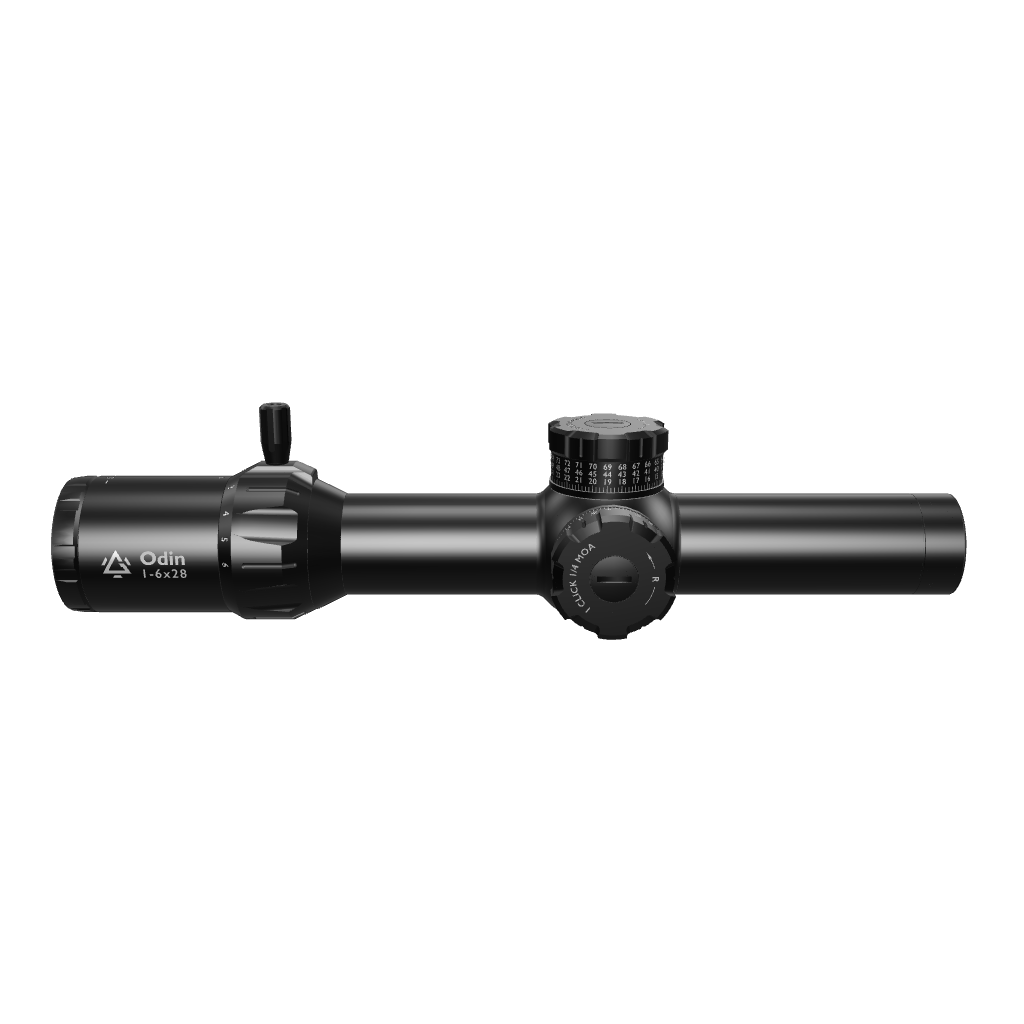LPVO vs MPVO
In my experience, the conversation around LPVOs vs. MPVOs is often about which one to get. Most people, after a meticulous consideration of the differences between MPVOs and LPVOs and the technicalities involved in setting up and using each type of scope, often end up settling for LPVOs.
But this is a very nuanced conversation, one in which you have to make the final decision by yourself.
So, here is a balanced comparison of LPVOs and MPVOs. We will clearly define what an LPVO and an MPVO are, discuss the main differences between the two, and explore the subtle nuances involved in choosing one over the other.
LPVO vs MPVOs: Which is Which?
Here’s a simple way to tell whether an optic is an LPVO or MPVO:
- An LPVO offers 1x magnification at the lower end; an MPVO does not.
- An LPVO typically reaches a maximum magnification of 10x, an MPVO can reach up to 18x.
- An LPVO typically has a smaller objective lens (24-28mm) compared to an MPVO ()
So, technically speaking, a 2.5-10x scope is not an LPVO, though the magnification range only goes up to 10x.
Some shooters like to dismiss this as semantics, but (as we will discuss later) 1x magnification is one of the most crucial differences between an LPVO and an MPVO. For now, here’s what to understand
A 2.5-10x scope, for example, does not have 1x magnification, so the majority of people will not count it as an LPVO.
The Gunnr Odin 1-10x FFP LPVO, on the other hand, is clearly an LPVO, even though it offers 10x magnification (which is higher, by LPVO standards).
Understand LPVO/MPVO Meaning
L.P.V.O. stands for “Low Power Variable Optic”, which means it offers low magnification (1x) and is designed to be suitable for low to middle-range shooting.
M.P.V.O. stands for “Medium Power Variable Optic”, which means that the optic has medium magnification (no 1x), and it is designed to be suitable for middle-range shooting.

LPVO vs MPVO: Magnification Range
The main difference between an LPVO and an MPVO is in the differences between the magnification range each optic offers.
- LPVO (Low Power Variable Optic): Magnification starts at 1x and typically ranges up to 6x, 8x, or 10x.
- MPVO (Medium Power Variable Optic): Magnification starts above 1x (typically 2.5x to 4x) and ranges up to 12x or 16x
Here’s a breakdown of more differences between LPVOs and MPVOs
| Feature | LPVO (Low Power Variable Optic) | MPVO (Mid Power Variable Optic) |
| Magnification Range | 1-6x, 1-8x, or 1-10x | 2.5-10x, 3-12x, or 4-16x |
| Low-End Capability | True 1x – allows for red-dot-like, both-eyes-open shooting | Starts above 1x – less effective for close-quarters use |
| Effective Distance | Close to mid-range (0–400 yards) | Mid to long-range (400+ yards) |
| Strength | Speed and flexibility in dynamic, close-to-medium environments | Precision and clarity at distance |
| Use Case | Tactical rifles, home defense, 3-gun competitions, patrol | DMR setups, long-range hunting, semi-auto precision rifles |
| Quick Target Transitions | Excellent – fast and fluid | Moderate – slower up close due to higher base magnification |
| Best Role | Versatile “do-it-all” optic for varied terrain and scenarios | Precision engagements where distance matters most |
The differences between LPVOs and MPVOs are quite clear but others are more subtle, and you may not realize them until you actually set up your optic and start using it.
Here are some factors to consider when deciding between an LPVO and an MPVO.
1. An LPVO has 1x Magnification
The biggest advantage of an LPVO over an MPVO is that it offers true 1x magnification. The difference between an LPVO’s 1x and an MPVO’s 2.5x or 3x might seem minor on paper, but it's a game-changer.

1x magnification turns your rifle into a hybrid between a red dot and a mid-range optic, and for many shooters, having 1x magnification is non-negotiable.
Here’s why:
- Without 1x, you are always compromising and have to slow down up close; the targets are over-magnified, and the setup is just less intuitive.
- With a true 1x LPVO, you can shoot with both eyes open, just like you would with a red dot. It's just easier, especially if you are in a situation where time and accuracy are of the essence.
So, the biggest drawback of an MPVO is that it does not offer 1x magnification
Can you Attach a Red Dot?
What I have seen some shooters do is attach a piggyback red dot on their MPVOs in order to compensate for the lack of 1x magnification.
If you absolutely cannot do without the longer range of an MPVO, that could be an option for you.
But your setup is going to be a lot heavier, and it takes some skill and versatility to switch constantly between the two optics. You might have to set up nicely and practice a lot.
However, my counsel will be to just go for an LPVO. No need to switch optics or rifles—an LPVO does it all with fluidity and speed.
If you are engaged in CQB, home defense, or fast-paced competition stages, you need the 1x magnification of an LPVO. It's not even a debate.
LPVO vs HPVO: Parallax, Objective Lens, and Other Features
Some differences in structure and features between LPVOs and MPVOs are often left out when comparing the two types of optics, but they do matter.
Here’s a clear comparison table of LPVO and MPVO features:
| Feature | LPVO (Low Power Variable Optic) | MPVO (Mid Power Variable Optic) |
| Parallax | Fixed parallax (usually set at 100 yards) | Many have adjustable parallax for precision at varying distances |
| Objective Lens Size | Smaller (typically 24–28mm) | Larger for better light transmission (40–50mm+) |
| Turrets | Often capped turrets (set-and-forget style) | Usually exposed turrets for frequent elevation/windage adjustments |
| Reticle Design | Simpler, speed-focused reticles (BDC, duplex, minimalist) | More complex and specialized (MIL/MOA grids, holdovers, etc.) |
| Optical Quality | Optimized for versatility and speed at low to mid-magnification | Enhanced glass for clarity and precision at longer ranges |
Here’s how these features might affect your choice of scope:
- If you prefer a more versatile parallax setting
- You are shooting in low light, so you’d probably want a larger objective lens
- A simple LPVO reticle will suffice in close quarters, but if you are a sniper in the making, you’d probably prefer a more intricate MPVO reticle design.
LPVO vs MPVO: Weight and Handling
The physical characteristics of these optics affect how they handle in real-world scenarios:
LPVOs are generally lighter and more compact, making them ideal for dynamic shooting, prolonged carrying, and quick target transitions
MPVOs are typically heavier due to more glass and additional features, better suited for more stationary precision shooting

LPVO vs HPVO: Performance Comparison
| Distance | LPVO Performance | MPVO Performance |
| Close Range (0–100 yds) | ExcellentTrue 1x magnification enables fast, reflexive shooting | Limited – Starts at 2.5x or higher, slower target acquisition |
| Medium Range (100–400 yds) | Good Upper magnification helps, but clarity can vary | Excellent – Optimized for this range with better glass and reticles |
| Long Range (400+ yds) | Limited – Max magnification often not sufficient for precision | Superior – High-end magnification, tracking turrets, and clarity |
Final Advice: Which One Should You Choose?
- An LPVO is better if you need versatility at close to medium range or if your shooting involves dynamic movements and quick transitions.
- MPVOs are designed for shooters who prioritize medium to long distance, primarily shoot from stable points, and rarely engage targets under 100 yards.
It Might Come Down to Weight
If you are still undecided, it might just come down to the weight and heaviness of the optic.
- If you want to stay slick, and lighter but with less capability, go for an LPVO.
- If you want to have more capability but take on a little extra weight and clunkiness, choose an MPVO.
I Personally Lean Towards the LPVO
My opinion is this: stick with an LPVO. In most shooting scenarios, it is just more practical to have an LPVO than an MPVO, even paired with an offset.
1-6x is more than adequate for the distances you are most likely to be shooting at. Even for the unlikely distances, 6x is more than enough, even for 500 yards.
You might be interested in this conversation about height over bore in shooting, and my recommendations for best tactical rifle scopes under $1000.









